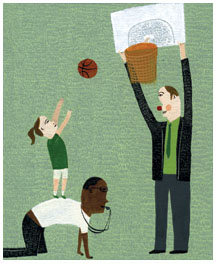
|
April 4, 2007: On the Campus
(Illustration: Marlena Zuber; photo: Hyunseok Shim ’08) |
Hoop dreams; food face-off
By Adam Gottesfeld ’07
In the Dillon Gym youth basketball league, the fiercest competition is among the student coaches.
The league is designed for local elementary-school-age boys and girls to play once a week under the tutelage of undergraduate volunteers. For Princeton students, it is a lighthearted but cherished responsibility. From the end of November through March, they live for game-day Saturdays.
Many of the coaches are friends and teammates on Princeton’s club basketball team. They want to win but, more importantly, they want to outdo their friends in zany sideline antics. They attend games in suits, and they encourage their players to shout good-humored jibes at the opposing coaches.
“It’s basically like being a counselor at a summer camp for two hours a week,” said Freddy Flaxman ’07, recently retired coach of the Sonics, a team of fourth- and fifth-graders.
Flaxman has spearheaded several sports-related initiatives on campus. He has captained the club team and helped found the Jadwin Jungle, a fan network for Princeton basketball. He also created the University’s annual dodgeball tournament and formed a charity whose mission is to get every athletic team on campus to raise $1,000 per year.
But coaching basketball, he said, has been one of his most rewarding experiences. Teaming up with his friend Patrick Ekeruo ’07, Flaxman came to his first practice armed with strategies to teach his players, 9- and 10-year-olds who were “full of energy.” The two coaches quickly scrapped their plans, allowing the boys to play knockout and compete in layup contests during practices.
During games, the two coaches encouraged layups and other two-point shots, rather than the daring three-pointers the kids all wanted to try. But the team didn’t always listen. With three seconds to go in the playoffs, the last game of the season for the Sonics, the smallest boy on the team heaved a shot from the NBA range three-point line. It went in, and Dillon erupted. All the players stormed the court and mobbed the boy.
“He absolutely nailed it. It was great to see the littlest guy on the team make the improbable shot,” said Flaxman. “That’s what it boils down to — to make it more fun for the youth.”
Former ambassador Dan Kurtzer, a lecturer at the Woodrow Wilson School, and physics professor William Bialek were unlikely candidates to compete in a formal debate. The former was a key negotiator in the Middle East peace process while serving as ambassador to Israel and Egypt. The latter is a leader in biophysics and an expert in brain functions.
But partnered with students, the two squared off March 7 at Princeton’s annual Latke-Hamantashen Debate, described by event host Michael Van Landingham ’08 as “one of the most raging debates in our society for the past 5,000 years.” The event drew a boisterous standing-room-only crowd to Whig Hall.
Kurtzer and classics major Aaron Souza ’08 took the side of the hamantashen, a triangular pastry commonly served during the late-winter Jewish holiday of Purim. Bialek and Wilson School major Ben Amster ’07 argued for the latke, a fried potato pancake eaten during Hanukkah.
Both Kurtzer and Bialek anchored their arguments in their respective disciplines. Attacking the latke, the ambassador said it symbolized the Jewish victory over the Syrians — and since Syria is next to Iraq, put in the modern day, the latke represents the invasion of Iraq.
“A vote for the latke is a vote for Bush’s Iraq policy. Are there any affirmative votes for our country’s latke policy?” Kurtzer quipped.
Bialek constructed an elaborate scientific argument, complete with graphs and visual aids, to show that the latke is superior because it can help scientists better understand the nature of matter. Just as string theory suggests that the building blocks of matter are miniature strings, so is the latke filled with potato strings.
Souza cited the superiority of the triangle shape in classical thought. But in what may have been the turning point of the debate, Amster demonstrated in a slide show the superiority of the experience of eating a latke compared to a hamantashen. In eating the pastry, he said, two-thirds of the time you just get dry crust.
The judges’ verdict? The latke won. ![]()
Adam Gottesfeld ’07, a Woodrow Wilson School major, is from Los Angeles.

To read our exclusively online On the Campus column, click here.
